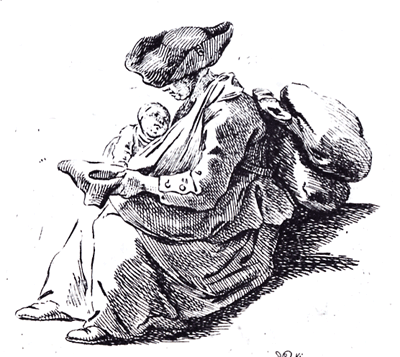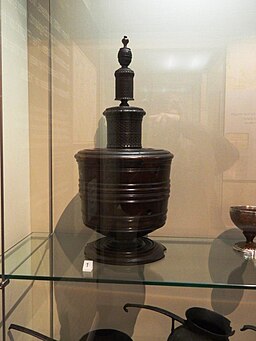by Maria Grace
Amidst all the fun and frivolity of the season, charity also played a large part of the Christmastide season. In addition to the normal parish collections, an number of other seasonal opportunities for charity came during the Christmas season.
 St. Thomas Day
St. Thomas Day
The Feast of St. Thomas the Apostle, celebrated on December 21st, became associated with charitable giving. Poor women would go a'Thomasing. This practice was especially vigorous during the early 19th century, perhaps because of the number of widows from the Napoleonic Wars. They would call at the principle houses in the parish and collect small coins or provisions toward Christmas dinner for their families.
The 'mumpers' often carried two-handled pots in which they received gifts of cooked wheat to make frumenty. In exchange, they offered small gifts or gave sprigs of holly, mistletoe, or handspun yarn and grateful good wishes to their benefactors.
Robert Chambers' Book of Days notes "that at Harrington, in Worcestershire, it was customary for children on St Thomas's Day to go round the village begging for apples, and singing — ' Wassail, wassail, through the town, If you've got any apples, throw them down ; Up with the stocking, and down with the shoe, If you've got no apples, money will do ; The jug is white and the ale is brown, This is the best house in the town.'"
Caroling and Wassailing
The practice of going door to door singing carols was known in the time of Shakespeare. Groups of, usually, lower class men went singing from house to house and remained until someone paid them for the efforts. Payment was more likely to make them go away rather than appreciation of their songs.
By the end of the 18th century, wassailing became less about outright begging and more about charity. Groups of working class men and women would go house to house looking for those with a candle in the window to signal they were welcome. If welcomed, they would sing and often receive coins, wassail, and food for their efforts. During the Regency, groups of carolers from the local village often ended their evening of caroling at the local land owner's manor house. Typically they would sing for the family and be treated to victuals and libations (frequently in the form of wassail) and a warm fire.
Mummers Play and Sword Dances
A more elaborate form of begging during the Christmas season came in the form of the Mummers Play.The main players, usually St. George and a soldier, introduced themselves before beginning their battle. Minor characters would appear with irreverent comedic scenes before a final song. At the end, the players would go amongst the crowd collecting money from the audience.
Like Mummers, teams of dancers would perform and collect donations. The Sword Dance had several variations including the Long Sword and Rapper.
The central feature of the Sword Dance was an interlocking star pattern made with the swords. The group would dance around the lock with one member in the center. The lock would be placed around their neck, and the dancers would circle around the 'victim'. The dance might end with the feigned death of the 'victim'.
More sedate means of charity were also practiced like church collections and charity baskets for orphanages and neighborhood families. More than the gift giving of today, the Regency Christmastide was a season of kindness and goodwill to friends and family and charity to those in need.
References
Robert Chamber’s Book of Days. (1862)
Hazzard , Kieran. A Regency Christmas. (2013)
Waugh, Joanna. Christmas Gift Giving. (2008)
~~~~~~~~~~~~
Maria Grace is the author of Darcy's Decision, The Future Mrs. Darcy, All the Appearance of Goodness, and Twelfth Night at Longbourn and Remember the Past. Click here to find her books on Amazon. For more on her writing and other Random Bits of Fascination, visit her website. You can also like her on Facebook, follow on Twitter or email her.
Amidst all the fun and frivolity of the season, charity also played a large part of the Christmastide season. In addition to the normal parish collections, an number of other seasonal opportunities for charity came during the Christmas season.
 St. Thomas Day
St. Thomas Day
The Feast of St. Thomas the Apostle, celebrated on December 21st, became associated with charitable giving. Poor women would go a'Thomasing. This practice was especially vigorous during the early 19th century, perhaps because of the number of widows from the Napoleonic Wars. They would call at the principle houses in the parish and collect small coins or provisions toward Christmas dinner for their families.
The 'mumpers' often carried two-handled pots in which they received gifts of cooked wheat to make frumenty. In exchange, they offered small gifts or gave sprigs of holly, mistletoe, or handspun yarn and grateful good wishes to their benefactors.
Robert Chambers' Book of Days notes "that at Harrington, in Worcestershire, it was customary for children on St Thomas's Day to go round the village begging for apples, and singing — ' Wassail, wassail, through the town, If you've got any apples, throw them down ; Up with the stocking, and down with the shoe, If you've got no apples, money will do ; The jug is white and the ale is brown, This is the best house in the town.'"
 |
| Wassail bowl |
The practice of going door to door singing carols was known in the time of Shakespeare. Groups of, usually, lower class men went singing from house to house and remained until someone paid them for the efforts. Payment was more likely to make them go away rather than appreciation of their songs.
By the end of the 18th century, wassailing became less about outright begging and more about charity. Groups of working class men and women would go house to house looking for those with a candle in the window to signal they were welcome. If welcomed, they would sing and often receive coins, wassail, and food for their efforts. During the Regency, groups of carolers from the local village often ended their evening of caroling at the local land owner's manor house. Typically they would sing for the family and be treated to victuals and libations (frequently in the form of wassail) and a warm fire.
 |
| Mummer's costume |
A more elaborate form of begging during the Christmas season came in the form of the Mummers Play.The main players, usually St. George and a soldier, introduced themselves before beginning their battle. Minor characters would appear with irreverent comedic scenes before a final song. At the end, the players would go amongst the crowd collecting money from the audience.
Like Mummers, teams of dancers would perform and collect donations. The Sword Dance had several variations including the Long Sword and Rapper.
| Modern sword dancers holding up a sword lock |
More sedate means of charity were also practiced like church collections and charity baskets for orphanages and neighborhood families. More than the gift giving of today, the Regency Christmastide was a season of kindness and goodwill to friends and family and charity to those in need.
References
Robert Chamber’s Book of Days. (1862)
Hazzard , Kieran. A Regency Christmas. (2013)
Waugh, Joanna. Christmas Gift Giving. (2008)
~~~~~~~~~~~~
Maria Grace is the author of Darcy's Decision, The Future Mrs. Darcy, All the Appearance of Goodness, and Twelfth Night at Longbourn and Remember the Past. Click here to find her books on Amazon. For more on her writing and other Random Bits of Fascination, visit her website. You can also like her on Facebook, follow on Twitter or email her.
No comments:
Post a Comment
Note: Only a member of this blog may post a comment.